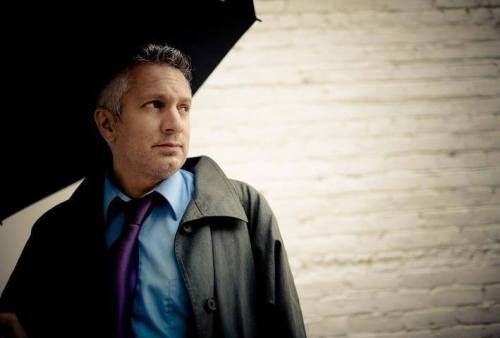
Samir Khurshid and Jim Lommasson at the first What We Carried exhibition in Portland, 2011
What We Carried: Fragments from the Cradle of Civilization is an ongoing project currently on view at the Arab American National Museum in Dearborn, Michigan and the Illinois Holocaust Museum in Skokie, Illinois. The exhibit includes photos and writings chosen from over 250 Iraqi and Syrian refugees of the objects they carried to <!–more–>America, such as abayas, Barbie dolls, coffee cups, Qurans, platters, milk cans, rugs, and flip flops. Some of the actual objects that refugees carried to America from their homeland are included in the exhibition.
Renowned freelance photographer and author Jim Lommasson of Portland, Oregon started this project as a way for Americans to meet the people who have been displaced and demonized in the media.
“It’s a bridge building project,” Lommasson said, explaining how it came about. “I was horrified that we invaded and occupied Iraq. One of the questions I wanted answered for myself is: what did the American soldiers feel about the war in Iraq?”
Believing in the power of pictures, and the idea that photography can change lives, Lommasson used his artistic talents to tell stories he hopes can bring about peace. In 2007, he created a traveling show and book about American troops called Exit Wounds: Soldiers’ Stories – Life After Iraq and Afghanistan.
Lommasson asked the soldiers how they felt about the war in Iraq. He was surprised that the vast majority of soldiers he interviewed admitted that the war was a mistake. Many had regrets, became anti-war activists, and some wanted to go back to Iraq as civilians and help rebuild the country.
“They wanted to tell us cautionary stories,” he said, “that we should not be so gullible for our leaders to bring us to war. Many said, ‘If foreigners came to our cities and neighborhood and started kicking in doors, we would do the same to them as the Iraqis did to us.’”
He realized that the consequences of war are horrific for everybody, so he thought that he should not only interview soldiers who fought in Iraq, but the affected Iraqi people, too. Lommasson sat down an Iraqi woman, who is now an academic in Portland. During the course of their interview, he asked her what she thought about the U.S. invasion of Iraq. She answered, “I thank America for getting rid of Saddam Hussein, but did they have to destroy the whole country to do that?”
That statement stuck with him, and it suggested a new project. Lommasson felt that people needed to hear from those “others” affected by the war. He soon learned that Iraqis, whether they came before or after 2003, shared universal stories.
Poet Dunya Mikhail brought with her a folder of stories written by her friend, famous Iraqi author, Lutfiya Al-Dulaimi, who now lives in Jordan.
“Although there’s an age gap between us, we were friends in Iraq,” Mikhail said. “Once she wanted to throw out this file in the garbage. I said, ‘What are you doing? Why are you throwing this out?’ She said, ‘What would I do with it? They’re already published.’”
Mikhail asked if she could have the file and Al-Dulaimi easily gave it to her. The file came along in the one suitcase that Mikhail brought along with her to America. While at a conference in Jordan last summer, Mikhail met with Al-Dulaimi and showed her the file she’d held onto for twenty years. She said to her friend, “You can keep it or let me keep it. But if you let me keep it that’s even better because they want to place it at a museum.”
Al-Dulaimi thought Mikhail was joking.
“The irony is that she wanted to throw it away and now it ended up in the museum,” said Mikhail.
Rafat Mandwee, a tour guide at the Arab American National Museum, also had from Iraq a blanket, which was over a hundred years old and previously owned by his great grandmother. He also brought a tin milk container, which was used during the 1950s and 60s. After the milk finished, people used it to store water.
“Some of the items people brought with them, like diaries, were sensitive material and too dangerous to bring out during Saddam’s time,” said Mandwee. “If they were caught, they would have risked their life. This required a lot of strength and courage on their part.”
“When you leave, you often leave under the veil of darkness and the things that you bring, you lose more along your travel, depending on your travel path,” Lommasson said. “It’s not really about what people brought, but what they left behind – their memories, cultures, education, families.”
Exit Wounds and What We Carried have traveled to universities, galleries, and museums. They have become books that have been embraced by the participant communities.
What We Carried will be going to Nebraska next where there’s a large Yazidi community.
Lommasson feels that this project is creating a new and unique language to tell stories.
“I wanted the American public to know the consequences of our government and the consequences of ignorance. George Bush told people to just go to the mall. We can’t just go to the mall,” said Lommasson. “We have to become aware and educated. The efforts we do – we have little effect moving the big picture, but we can have an effect on one-on-one relationships.”
This article was written for, and originally published by, Arab America http://www.arabamerica.com/78783-2/










